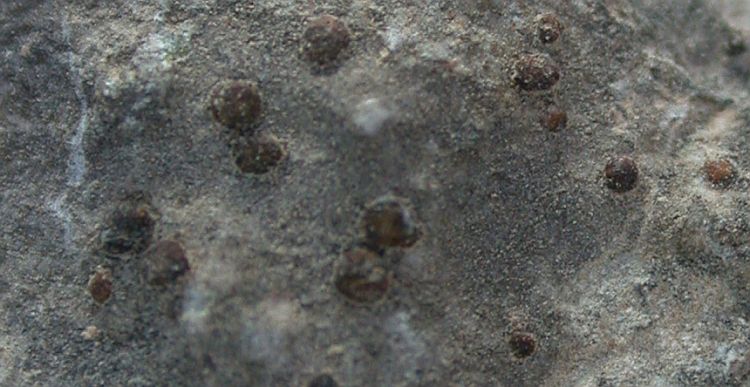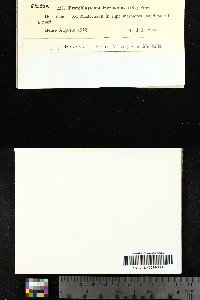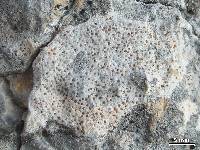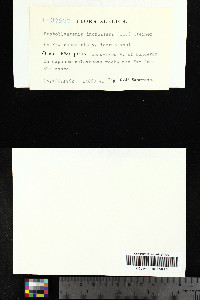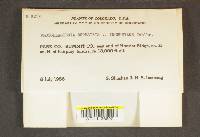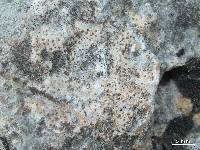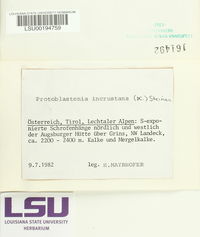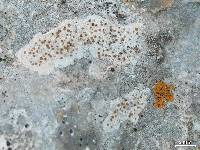
- Home
- Search
- Images
- Species Checklists
- US States: O-Z >
- US National Parks
- Central America
- South America
- US National Parks
- Southern Subpolar Region
|
|
|
|
Family: Psoraceae
[Biatora incrustans (DC.) A. Massal., moreCallopisma rupestre f. incrustans (DC.) Walt. Watson, Caloplaca incrustans (DC.) Flagey, Caloplaca incrustans f. incrustans (DC.) Flagey, Caloplaca incrustans f. nicaeensis B. de Lesd., Caloplaca incrustans f. soredlosa B. de Lesd., Caloplaca incrustans var. incrustans (DC.) Flagey, Caloplaca incrustans var. urbana B. de Lesd., Lecanora incrustans (DC.) Ach., Lecanora irrubata f. incrustans (DC.) Cromb., Lecanora rupestris f. incrustans (DC.) Leight., Lecidea incrustans (DC.) Chevall., Lecidea rupestris var. incrustans (DC.) Schaer., Patellaria incrustans DC., Placodium citrinum f. incrustans (DC.) Räsänen, Placodium incrustans (DC.) A.L. Sm., Placodium rupestre f. incrustans (DC.) A.L. Sm., Protoblastenia rupestris var. incrustans (DC.) Zahlbr.] |
Global occurrence: Eurasia – Asia Extratropical | Eurasia – Europe | Americas – North America (incl Mexico) | Arctic. Substrate: rock – calcareous, calciferous, basic | rock, stones, pebbles – unspecified. Life habit: lichenized (mutualistic with algal photobionts). Thallus: crustose (crustaceous) – endosubstratal, inconspicuous, immersed | crustose (crustaceous) – episubstratal – unspecified; continuous, diffuse, effuse | cracked, fissured, fractured, rimose; [th] upper surface: brown(ish) (if pale: fawn, tan; if mid: cinnamon) | white(ish) | white(ish) grey; [th marginal and upper surface] specific structures: absent. Ascomata: absent | present; ascoma: apothecial, apothecioid – hymenial; ascoma [mm]: (min) 0.2 (low) 0.3(median) 0.4 (high) 0.55 (max) 0.85; ascoma: immersed, innate | subsessile, subimmersed, adnate, semi-immersed, emergent; [ascm, if apoth] disc, mazaedium: concave | plane, flat, flattened, expanded | subconvex, slightly convex; [ascm, if apoth] disc, mazaedium: red(dish) yellow (orange, orange yellow) | yellow(ish) red (orange red); [ascm, if apoth] margin surface; [if perith] periostiolar area, ostiole, involucrellum: yellow(ish) red (orange red); [ascm, if apoth] margin excipular photobionts: absent; [ascm, if apoth] subhymenial layers, hypothecium; [if perith] basal excipulum: yellow(ish) (if dull: buff) | hyaline, colourless; [ascm] paraphyses/-oids: present; [ascm] paraphyses/-oid cells width [µm]: (low) 1.5(median) 2.5 (high) 3.5; [ascm] paraphyses/-oid apical cells width [µm]: (low) 2.0(median) 3.2 (high) 4.5; [ascm] epihymenium, epithecium: brown(ish) (if pale: fawn, tan; if mid: cinnamon) | red(dish) yellow (orange, orange yellow) | yellow(ish) red (orange red). Asci: lecanoralean; [asc] tholus: thickened; [asc] tholus amyloidity (iodine reaction): present; [asc] tholus amyloidity pattern: with amyloid tube, ring (= Collema-, Micarea-, Porpidia-, Psora-types etc). Ascospores: (median) 8.0; [asp] shape: broadly ellipsoidal | ellipsoidal | ovoid, ovate; [asp] length [µm]: (low) 9.0(median) 10.9 (high) 12.5 (max) 13.0; [asp] width [µm]: (min) 4.0 (low) 4.5(median) 5.6 (high) 6.0 (max) 7.0; [asp] septa: absent – spore lumen unilocular, monolocular; [asp] pigmentation: hyaline, colourless; [asp] perispore, epispore: not apparent. Conidiomata: absent | present. Conidia: cylindrical | bacilliform, bacillary. Secondary metabolites: present, unknown/unidentified anthraquinone(s). Primary photobiont: present, chlorophytaceous – trebouxiaceous, chlorococcoid. Secondary photobionts (eg in cephalodia): absent. |

